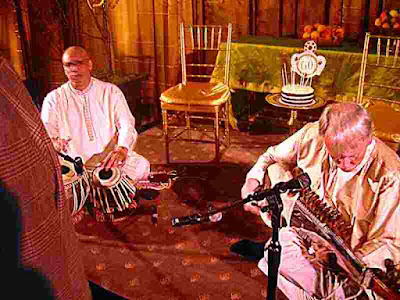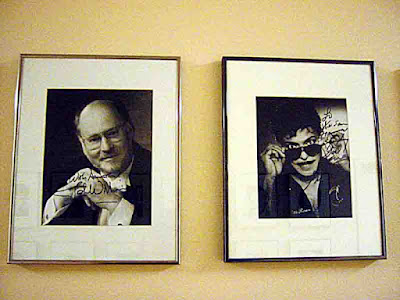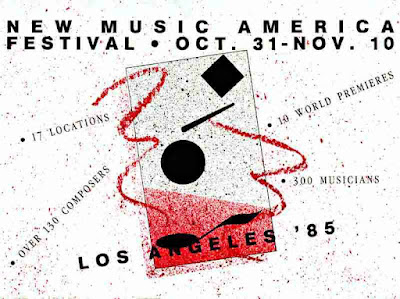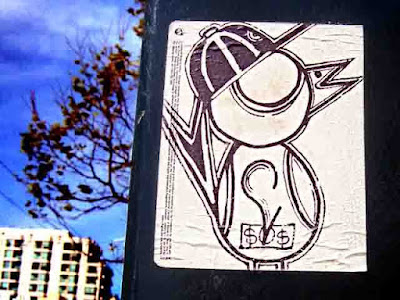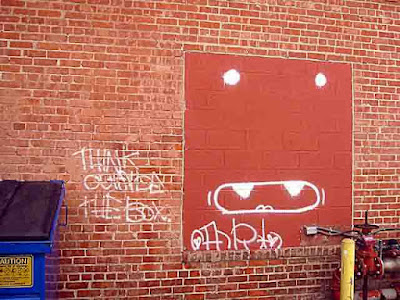The Improvising Guitarist, mysterious force behind the blog The Improvising Guitar, provided this example in a post entitled daily recommended traditional intake:
| Tradition Facts | |
| Performance Duration 65' 00" | |
| Amount Per Performance | |
| Improv 48' 20" | From Jazz 25' 00" |
| Total Improvisation | 74% |
| Non-Idiomatic | 8.5% |
| Jazz | 55% |
| Hard-Bop | 0.5% |
| Free Jazz | 40% |
| Trans-European | 15% |
| Euro-American | 10% |
| Rock/Pop | 35% |
| Folk | 20% |
| Nomadic | 8% |
| Non-Western | 12% |
| Musician may be nuts. Jazz content may be higher than taste suggests. | |
Certain packages might catch my eye because of bright colors or a surreal title or an obscene cover. But if that's all you know about a disk the chances of accidentally purchasing something interesting are zero. New CDs are exorbitantly expensive if you only play them once.
But a government mandated contents disclosure label (such as TIG's) would provide clues. I could make an informed choice by comparison shopping. Are there a lot of pop classics in this album? A lot of classical pop in that one? How about mindless-electronica, soft jazz, softer rock or misogynistic hip-hop? What if you're into Polynesian micro-tonal ska? (A Better Buy would be if Best Buy allowed me to listen to any album before purchase. That's pretty funny.)
Q: What are these people doing in my local Best Buy?

A: Playing a video game.
Suppose the government did mandate such a label on all music; it would mean a vast new bureaucracy. Finally full employment for otherwise unemployable music school graduates. They could sit in cubicles identifying album contents by inspecting the underside of CDs with microscopes; search out that imaginary musical DNA. Pandora.com already does this with the Music Genome Project.
Of course, such a huge government project could never lead to censorship. Never. Nope. Can't happen here. Read all about music censorship in general and the PMRC, in particular.
The Improvising Guitarist also recently referred to the breathless question "Is Jazz Dead?" This reminded me of the myriad boring blog posts out there in Internet-land arguing the question "Is Classical Music Dead?" And that reminded me of this snap I took in a Vons grocery store.

I didn't bother to look inside to find out what the 10 reasons for Hip Hop's non-death might be. But it made me think I'd post my own musical obituary list. Remember, just because a music is dead doesn't mean you can't enjoy it - or imitate it - or worship it.
1) Classical Music has been dead pretty much since Bartok died. Problem is, people are still paying their respects every week by buying tickets to hear the same pieces over and over. Most of the audience wouldn't give a rats ass if all the orchestra and chamber music of the last 60 years just disappeared in a puff of
2) Jazz died much more recently. Every time someone is awarded a Doctorate in Jazz Studies jazz dies a little more. That also means that Jazz is becoming another Classical Music. This ought to be regarded as a kind of victory. Now we have two classical musics.
3) Rock and Roll is not dead, it is merely in a Persistent Vegetative State. The heart of Rock (the evil Back Beat) simply will not die.
4) Hip Hop, as the magazine cover says, is not dead. However Hip Hop has recently discovered its own mortality. It has recently learned that it ain't gonna live forever. Scholarly biographies, reunion tours and professors of Hip Hop can't be far behind. I saw a DJ with a Karaoke machine doing a kids birthday party at a Pasadena restaurant recently. I didn't get a picture - but I remember seeing the word "dizzle" in the lyrics.
Does all this make you want to listen to some music? Here are two albums that I have discovered in the last few days and enjoyed. The downloads are free.
Sid Peacock - You can't buy everything forever. Comes from somewhere UK-ish I think. I learned about this album from Kill Ugly Radio.
 Móveis Coloniais de Acuja from Brazil. The name means Colonial Furniture of Acuja (a kind of wood apparently). Here's their website translated into apparently a kind-of-English by Altavista. And there's a fun video to watch on their MySpace space.
Móveis Coloniais de Acuja from Brazil. The name means Colonial Furniture of Acuja (a kind of wood apparently). Here's their website translated into apparently a kind-of-English by Altavista. And there's a fun video to watch on their MySpace space.Musical Content Tags: Improvising Guitar. . . The Improvising Guitarist. . . music labels. . . Kylie Minogue. . . Best Buy. . . compact discs. . . jazz is dead. . . classical music is dead. . . doctorate in jazz studies. . . hip hop is dead. . . rock is dead. . . Sid Peacock. . . Móveis Coloniais de Acuja. . . Pandora.com
P.S. I bought the Kylie Minogue album because I've started reading this. I'm pretty sure I already have the Alvin Lucier somewhere.
P.P.S. No I don't have I Am Sitting In A Room (although I have other Lucier recordings). Strangely, Paul Morley (in his book) says he doesn't have a copy either. (P.P.S.2 - Download I Am Sitting In A Room here.)
P.P.P.S. The Death of Classical Music reared its ugly head in the blogospheric realm again this very day. Click here to read how Alex Ross thinks Classical Music isn't dead because Classical CDs are still selling. By that logic, Ross must believe that Elvis isn't dead yet either.

